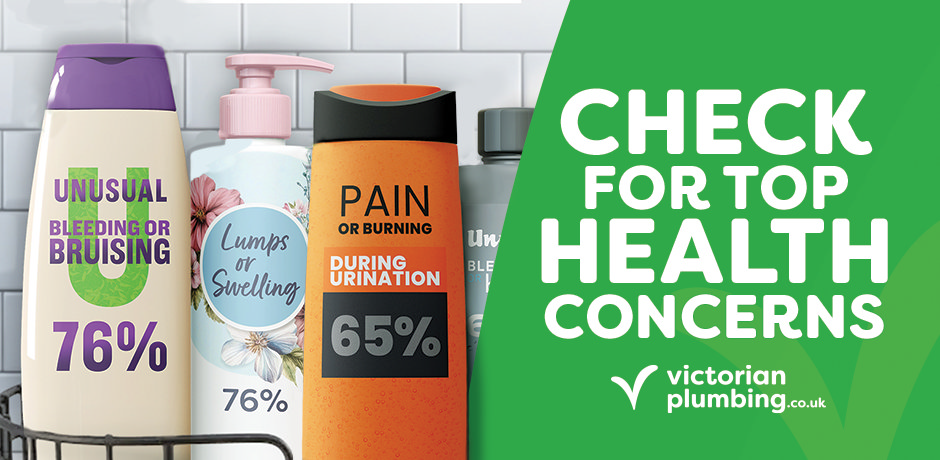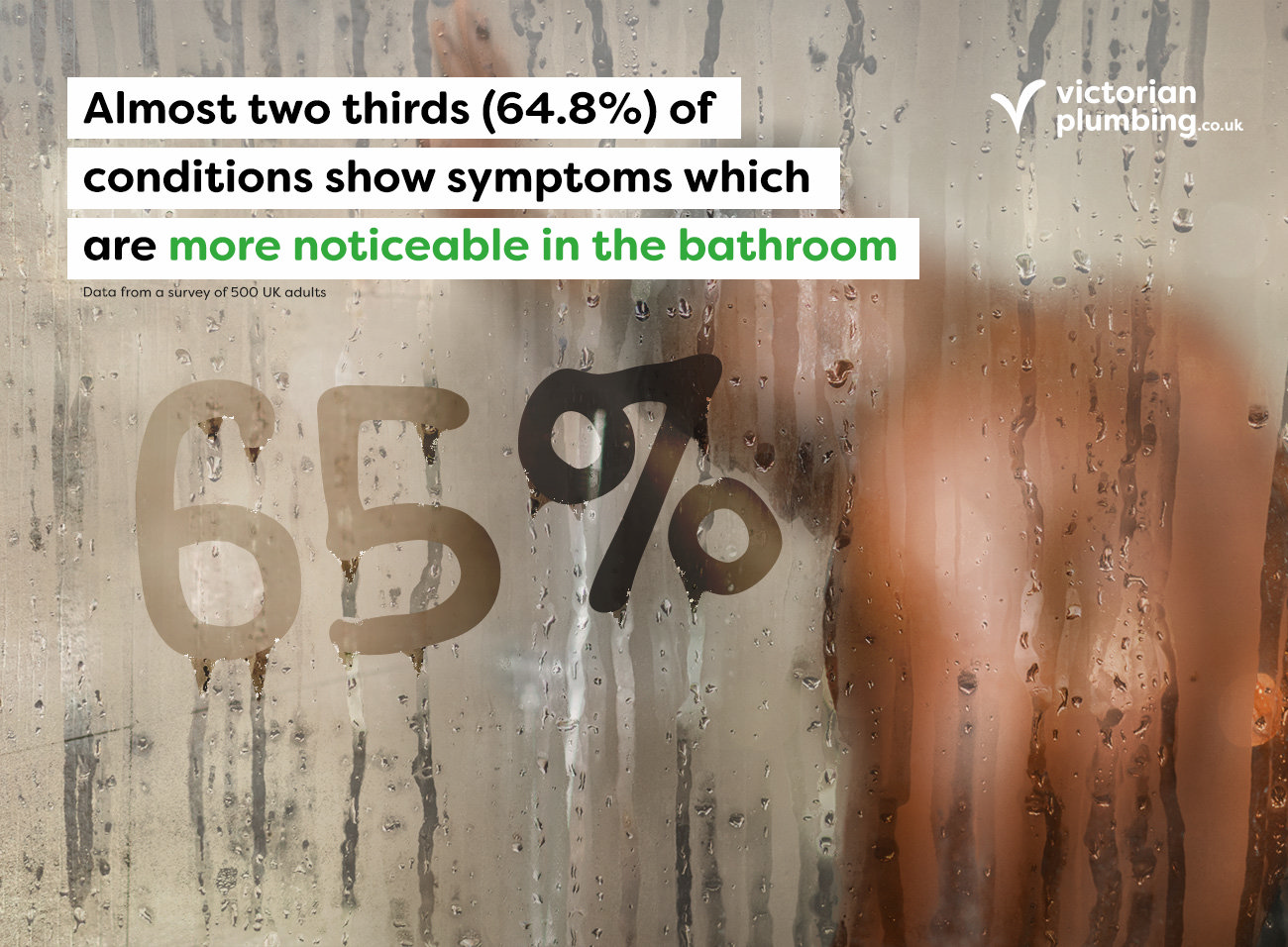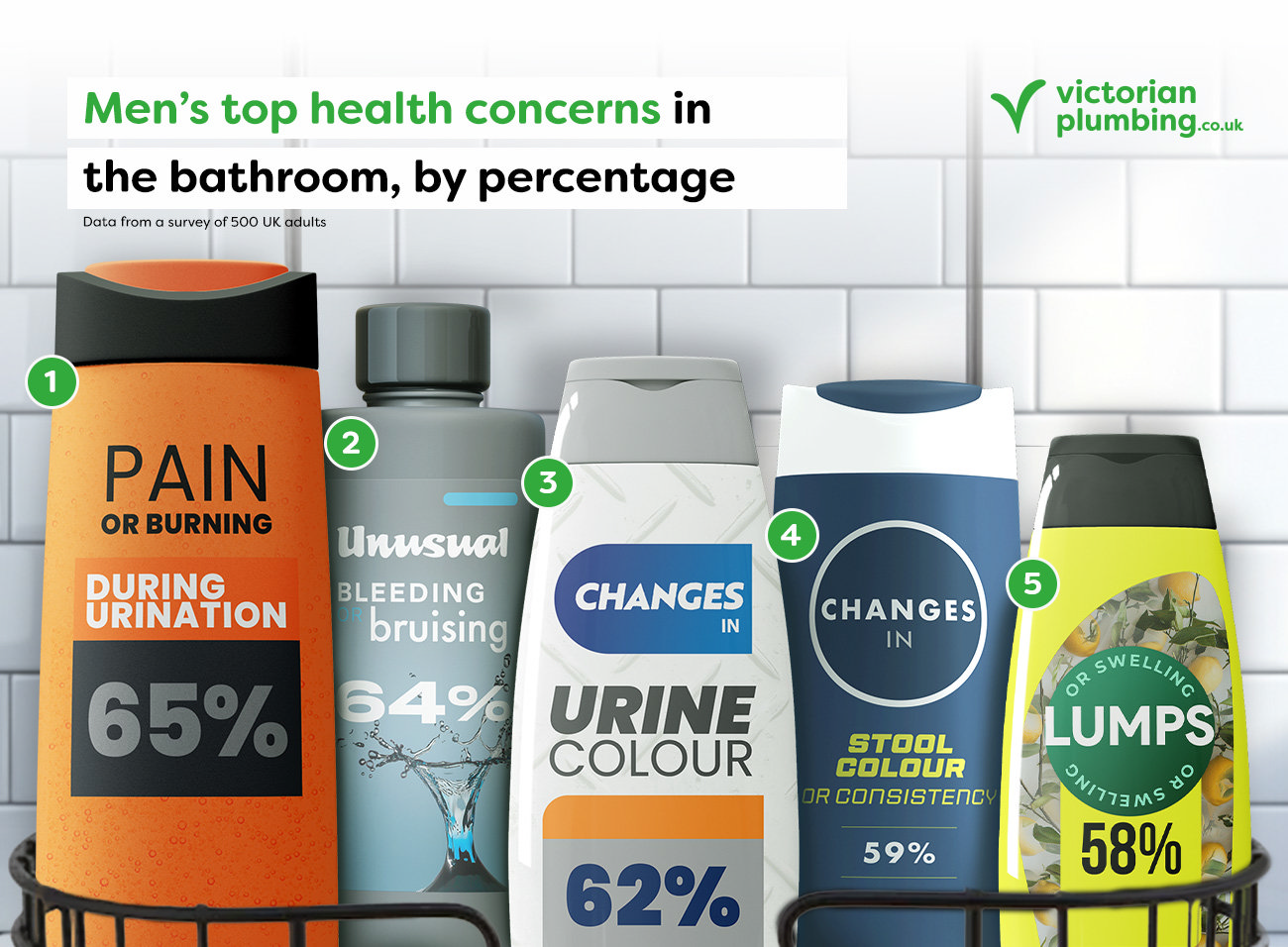OUR BOXING DAY SALE ENDS SOON!
Free delivery on orders over £499*
Just a Minute: A Life-Saving Bathroom Habit
Just a Minute: A Life-Saving Bathroom Habit
For the sake of your health, stop and check for just a minute - it could save your life

Your bathroom isn’t just a place to freshen up—it’s where early signs of health issues often reveal themselves, making it the perfect spot to monitor your well-being. Self-monitoring can help you pay attention to small changes in your body and regularly check for indicators or irregularities. After all, you know your body best. Taking a moment to check for anything unusual, like irregular lumps and bumps, can help you catch potential health conditions early.
We aim to raise awareness of health symptoms that often reveal themselves in the bathroom and encourage people to take ‘just a minute’ to check for these symptoms for an earlier diagnosis. Speaking with Dr Gareth Nye, Lecturer and Researcher at the University of Salford, we have gained professional insight, and proactive advice about how to examine yourself properly and why a small, proactive step like this can lead to early detection and better health outcomes.
Using the NHS website, we analysed every condition to highlight all of the visible symptoms that can be found in the bathroom, whether these symptoms are found when in the shower, in the toilet, using the mirror, or using bathroom scales, amongst others.
To better understand people’s bathroom habits and how often they check themselves, we surveyed 500 UK-based men and women - shedding light on what’s really happening behind the shower curtain.
Over 60% of conditions have symptoms most noticeable in the bathroom
Our study found that over 1 in 6 (64.8%) of all health conditions on the NHS website are most noticeable in the bathroom.

90% of symptoms found in the most common STIs such as chlamydia, gonorrhoea, and syphilis can be found in the bathroom.
Symptoms of conditions such as diabetes, cystic fibrosis, and hypothyroidism all can be found in the bathroom, including blood in urine or stool, skin changes, or irregular bowel movements.
Frequent urination is a common symptom of diabetes, while digestive issues like constipation can indicate cystic fibrosis - both of which are signs that may become noticeable during your time in the bathroom.
Many autoimmune conditions such as arthritis, celiac disease, Crohn's disease and multiple sclerosis (MS), can also be found in the bathroom.
9 in 10 cancers show symptoms in the bathroom
Our study revealed that 91% of cancers show symptoms in the bathroom. These can include: lung cancer, bone cancer, thyroid cancer, pancreatic cancer, kidney cancer, cervical cancer, and bladder cancer.
Research from Cancer Research UK shows nearly all women with early-stage breast cancer survive 5 years. Over 90% with early-stage bowel cancer survive 5 years, compared to 10% at advanced stages. Similarly, about 60% with early-stage lung cancer survive 5 years, dropping to less than 10% at advanced stages.
Early cancer diagnosis is key, especially as diagnoses rose 5% from 2021 to 2022, averaging 948 daily. Contributing factors include an ageing population, processed foods, unhealthy lifestyles, and air pollution. However, advances in early detection and screening also ensure timely and effective treatment.
According to the Office for National Statistics, colon and kidney cancer patients see the greatest increase in chances of survival when diagnosed at an earlier stage, there is a net survival of 93.4% and 88.9% respectively, if detected at stage 1.
Cancer Research UK advises self-checking for cancer, but doing so with caution to prevent unnecessary tests or paranoia. It is recommended that to notice any abnormal changes in your body, you check for changes in appearance and feel. Being self-aware is the first step in detecting possible cancer concerns.
Early diagnosis
Early diagnosis enhances treatment options, reduces cancer spread, and improves outcomes. Many non-communicable diseases (NCDs) can often be prevented through early detection, a healthy lifestyle, and regular health checks. While the causes of NCDs aren't always clear, staying active, maintaining a balanced diet, and prioritizing health screenings are key to lowering risks. Early diagnosis also benefits healthcare providers by minimizing complications and resource demands, enabling the NHS to manage more patients effectively despite ongoing budget constraints and system strain.
86% of male-specific conditions have symptoms more noticeable in the bathroom
Male-specific conditions which are likely to show symptoms within the bathroom include Klinefelter syndrome, prostate cancer, testicular cancer, penile cancer, prostatitis, epididymitis, and balanitis.
By analysing all male-specific conditions, data reveals that 86% show symptoms which are more noticeable in the bathroom, including lumps in testicles and frequent urination.
45% of men don't check for lumps in the shower
Our survey revealed on average, only 10% of men check themselves regularly and 9% are concerned about typical bathroom-related symptoms. In essence, just 1 in every 10 men show consistent care for their health by checking themselves.

According to the survey, a shocking 45% of men don’t check for lumps in the shower. Despite 58% of people noting lumps and swelling as a cause for concern.
Men are least worried about hair loss with 94% not noting it as a cause for concern, and 93% not concerned about changes in urination frequency and unexpected weight changes, despite all of these symptoms contributing to a possible diagnosis of a serious health condition.
Pain or burning during urination, unusual bleeding or bruising, and changes in urine colour were the most concerning for men, all of which 11% of men expressed concern.
All prostate cancer symptoms can be found in the bathroom
Of all prostate cancer symptoms on the NHS website, 100% can be found in the bathroom. We found that only 17% of males regularly check for lumps in their testicles and 7% check for changes in urination frequency, despite these being the leading symptoms of prostate cancer.
Studies show there were 55,093 cases and 12,039 deaths in the UK over a 3 year period, yet there was a 78% survival rate. Although there aren't any preventable factors per se, an early diagnosis can help improve treatment options and prevent it from becoming malignant.
It’s understood that men may avoid self-checking due to the stigma around vulnerability and traditional masculinity. This can lead to ignoring symptoms of male-specific conditions like testicular or prostate cancer. Thankfully, with charities such as ManHealth, there seems to be a growing awareness in shifting these attitudes, emphasising the importance of early detection for better health outcomes.
Dr Gareth Nye commented: “A lot of the signs and symptoms men may face could be considered embarrassing to discuss. Peeing more than usual could be a sign of diabetes or a growth of the prostate gland…erectile dysfunction could be linked to cardiovascular conditions or diabetes for example. This is compounded by the notion that men shouldn't seek help from doctors and remain ‘strong’. Men are also far more likely to hide mental health conditions which is linked to higher rates of suicide. Being more open about health and well-being in males could prevent a large number of unnecessary deaths.”
36% of women don't check for lumps in the shower
According to the survey, 36% of people don’t check for lumps in the shower. Despite 76% of people noting lumps and swelling as a cause for concern.
On average, 10% of women check themselves regularly, and 9% are mindful of typical bathroom-related symptoms. Although these figures are alarming, they also highlight how similar men and women are in approaching self-checking in the bathroom.
Over 82% of female-specific conditions have symptoms more noticeable in the bathroom
Of all female-specific conditions, 82.4% show symptoms in the bathroom, which include, but are not limited to: ectopic pregnancy, polycystic ovary syndrome, PMS (premenstrual syndrome), endometriosis, a miscarriage, ovarian cancer, and cervical cancer.

As with what conditions men are most concerned about, females are very much the same. Changes in urination frequency, hair loss, and unexpected weight changes are the least concerning. However, women showed the most concern for symptoms such as unusual bleeding or bruising (11%), lumps or swelling (11%), and changes in urine colours (10%). Dr Gareth Nye reinforces that lumps and swellings, particularly in and around the breast, can be a cause for concern, as they “can be early signs of breast cancer and should always be taken seriously.”
The percentage of men and women concerned about symptoms that could lead to serious health problems is notably minute. But, on a more positive note, our study found that almost 1 in 5 women regularly check for lumps in the breast, which is a key indicator of breast cancer. According to research, breast cancer is the most common cancer in the UK, with one woman being diagnosed every 10 minutes - an early diagnosis can help alleviate these figures.
On average, Brits spend 6-10 minutes in the shower, just a few extra minutes could catch an early diagnosis
On average, how long do you spend in the shower each day?
| Time spent in the shower | Answers |
|---|---|
| 6–10 minutes | 40.80% |
| 11–15 minutes | 26.20% |
| 5 minutes or less | 19.80% |
| 16–20 minutes | 8.80% |
| 21–30 minutes | 2.80% |
| More than 30 minutes | 1.60% |
The shower is an ideal place to self-check for early signs of health conditions, as feeling for changes whilst washing is an important habit to adopt. Our survey found that 6-10 minutes is the average time Brits spend in the shower, yet spending just a little longer to check for changes could make a big difference in getting an early diagnosis and treatment. In essence, this simple step could lead to a longer life.
Dr Gareth Nye has provided recommendations on how long to check your body and the best way to do so: “It should take around 5 minutes to fully check one area of the body. The best way to check for abnormalities is to understand what is normal for you, in essence, you need to be regularly checking yourself throughout your life to notice anything abnormal.
Understanding your breasts or testicles normally is one of the easiest places to start. It's key to be able to feel any new lumps or growths. It's particularly useful to check testicles in the bath or shower which is warmer than the outside temperature so the scrotum is relaxed and you can feel the whole testicle surface.
Breast examination in both males and females is also easier when relaxed. As well as checking for lumps, and looking for changes in shape, size or colouration of the breast and areola.
Skin changes or moles are another very common issue which can be monitored easily. You should be aware of the moles on your body and be looking for any changes in terms of shape, size and colour. Any new mole, or moles which have irregular edges or are not symmetrical should be assessed by a healthcare professional.”
Only 6% of Brits would consider changes in urine frequency a concern, despite it being a key symptom of diabetes and UTIs
Which of the following bathroom-related signs would you note as cause for concern?
| Bathroom-related signs | Answers |
|---|---|
| Unusual bleeding or bruising | 11.10% |
| Lumps or swelling | 10.66% |
| Pain or burning during urination | 10.59% |
| Changes in urine colour (e.g. blood in urine, cloudy urine) | 10.40% |
| Changes in stool colour or consistency (e.g. diarrhoea, constipation, blood in stool) | 10.12% |
| New moles or changes to existing moles | 9.86% |
| Rashes or skin irritations | 8.59% |
| Changes in bowel frequency | 8.02% |
| Unexpected weight changes | 7.36% |
| Hair loss | 6.34% |
| Changes in urination frequency (e.g. increased or decreased urination) | 5.96% |
| None of the above | 0.98% |
Brits tend to ignore bathroom-related health signs, arguably dismissing them as minor or temporary. However, all of the above-mentioned health issues could lead to bigger problems down the line. Reluctance to seek help can ultimately delay diagnosis and treatment, making conditions harder to manage.
Unusual bleeding or bruising for example, of which only 11% of Brits would be concerned about, could be a sign of a blood disorder, vitamin deficiencies, or even leukaemia.
Again, almost 1 in 10 Brits are concerned about lumps or swelling of the skin, despite it being commonly known as a sign of cyst, infection, or cancer.
We found that 1% of Brits would not be concerned about any of the bathroom-related signs outlined in the survey. While this may seem like a very small percentage, according to the current UK population, it equates to 693,758 Brits not showing any concern, roughly the entire population of Sheffield.
Expert urges people to check for lumps, as only 11% admit to
Which of the following (if any) do you regularly check in the bathroom?
| Health symptom | Answers |
|---|---|
| Appearance of stool in the toilet | 13.64% |
| Lumps in breasts | 10.88% |
| Changes in urine colour | 10.82% |
| Rashes or skin irritations | 10.76% |
| Unusual bleeding or bruising | 10.45% |
| New moles or changes to existing moles | 10.14% |
| Lumps in testicles | 8.60% |
| Changes in bowel frequency | 8.42% |
| Changes in urination frequency | 6.21% |
| Unexpected weight changes | 5.84 |
| None of the above | 4.24% |
On average, 9.58% of Brits regularly check for the most noticeable health condition symptoms.
Despite the NHS recommending to check your breasts monthly for any abnormal months, only 10.88% do so, that’s equal to just 1 in 10 following the advice given to them. Similarly, only 9% of Brits check for lumps in the testicles.
Self-diagnosing: Hysteria or proactive?
While being vigilant about health issues is important, self-diagnosing based on subtle changes found in the bathroom can sometimes lead to unnecessary panic and paranoia. It’s easy to jump to conclusions on Google (we’ve all been there), but this can often result in worrying over issues that may not even be present.
Speaking on this, Dr Gareth Nye commented: “Self-diagnosis can lead to worry and anxiety unnecessarily if seeking advice from the Internet for example. Many of the above signs are also indicators of conditions which are not serious but should still always be checked out. Being aware of what's normal for you, being aware of changes, and getting professional advice as soon as you can is the best way to ensure you are healthy and prevent unnecessary anxiety.”
On the whole, it’s important to approach self-checks sensibly; use your bathroom as the first place to monitor any changes without thinking the worst.
Comments from Victorian Plumbing
Alex Woods, bathroom expert at Victorian Plumbing says:
“The data shows that Brits are more often than not, not checking for any health-related abnormalities regularly, and also not allowing themselves the time to do so. We live in a fast-paced world, but the evidence shows that checking yourself is in the middle of you and an early diagnosis.
Here at Victorian Plumbing, we are more than aware of how a bathroom serves you; it’s more than a toilet and shower, it’s a place for you to care for yourself in solitude. If our findings provide you with anything, we’d hope to enlighten you to take just a minute and check yourself for any symptoms you may previously have ignored.”
Where to seek help for health-related concerns
If you notice any concerning symptoms, it’s important to seek guidance from trusted healthcare sources.
For general advice, you can visit the NHS website at www.nhs.uk or call 111 for non-emergency medical concerns. If you’re experiencing urgent symptoms, always call 999.
Additionally, organisations like Cancer Research UK and the British Heart Foundation provide valuable information and support for specific conditions.
You can find more information about Cancer Research UK here: https://www.cancerresearchuk.org
You can find more information about the British Heart Foundation here: https://www.bhf.org.uk
Giving thanks to Dr Gareth Nye, Lecturer and Researcher at the University of Salford, who has provided expert advice on self-examination and its importance when prioritising health.
Methodology
Aiming to improve public health awareness, this study focused on identifying potential health indicators that individuals may observe during their daily bathroom routines. By analysing NHS condition pages for symptoms related to bowel, bladder, genital, and oral health, a comprehensive list of bathroom-observable symptoms was compiled. This list informed a survey of 500 UK adults, investigating their self-examination habits and bathroom routines to assess potential gaps in health awareness.

Jack
Jack is part of the resident bathroom bloggers team here at Victorian Plumbing. As a bathroom décor and DIY expert, he loves writing in depth articles and buying guides and is renowned for his expert 'how to' tutorials.


